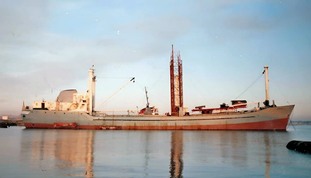© 2014-

Stereo 531/Stereo Hits 576
On 5th January 1986 the Mail on Sunday newspaper carried a report suggesting that a new offshore station -
The Mail on Sunday report also indicated that the new station would be based on a 450,000 ton former oil tanker, Burmah Endeavour, which was then laid up in Southampton, although this was strongly denied by the Burmah Oil Company.
In fact the journalist who wrote the story was close to the truth because the project's actual vessel, the MV Nannell, was also laid up in Southampton at that time, being secretly refurbished for her new role. The Nannell's cover story was that she had been purchased by a scrap metal company, but had subsequently been found to need extensive repair work in order that a marine safety certificate could be issued.
It was not long before press reporters linked the Nannell to the proposed offshore station and it became imperative to relocate the ship before any official action was taken against her. A local newspaper in Southampton, the Evening Echo, broke the story on 1st February 1986 when it revealed that the Nannell was to be the home for the new offshore station Stereo 531. The DTI were quoted in the article as admitting that they knew of plans for another offshore station and that they were aware of the Nannell's possible involvement.
Another vessel adjacent to the Nannell in Southampton, the Silver Sea, also came under suspicion and was used by those involved with the offshore radio project to divert journalists and others expressing an interest away from their own ship.
Following publication of these press reports an attempt was made in mid-
Meanwhile the Nannell, which had also suffered engine problems requiring a visit to Plymouth for repairs, eventually arrived in the northern Spanish port of Santander (where Radio Caroline’s Ross Revenge had been fitted out in the early 1980's) and here it was intended that transmitting, studio and broadcasting equipment would be installed.
In mid March 1986 reports appeared in the trade press that two stations would now be launched from the Nannell -
The British DTI approached the Spanish authorities putting pressure on them to prevent any further work being carried out on the Nannell. When the Spanish Ministry of the Interior instructed that work should cease on the Nannell (on spurious grounds that she was registered in Honduras and therefore required a Honduran broadcast licence) the project's backers thought it prudent to move their vessel. On 31st March the Nannell left Santander, supposedly heading for Oran in Algeria, but in fact she quietly slipped into a small port in southern France where she remained undiscovered for some time.
The unexpected need to move port and the consequent setback in fitting out the Nannell added to the already long delays incurred on the project and some of the initial financial backing was lost as a direct result. A further consequence was that the DJs and engineering crew who had been assembled in Spain had to be paid off and sent home while new sources of financial backing were sought.
Surprisingly this was achieved by mid May 1986 and the Nannell (now re-
The Nannell was forced to leave Santander in northern Spain rather hurriedly on 10th June 1989 after the Spanish authorities started showing an unusual amount of interest in the vessel, which by now had been re-
It later became clear that the increased level of interest in the Nannell was (as with the Communicator in Lisbon) part of the preliminary investigations into the planned launch of new offshore stations which ultimately led to the Dutch/British raid on the Ross Revenge in August 1989.
On the voyage north to Blankenbergo off the Belgian coast the Nannell/Mia Migo lost part of her newly erected aerial tower and one of the transmitters on board was also damaged. Reports circulating at this time suggested that some of the people formerly involved with Radio Mi Amigo now controlled the ship (hence her renaming) and plans were in hand to re-
In 1990 the owners of the ship decided to scrap the vessel, and in September the Nannell/Mia Migo was scrapped In Zeebrügge (Belgium).
MV Nannell (Mia Migo)
 Built in 1956 at the S.A. Juliana Const. Gijonesa shipyard the ship was named MV Monte Cuatro.
Built in 1956 at the S.A. Juliana Const. Gijonesa shipyard the ship was named MV Monte Cuatro.
Her length was 244 feet 4 inches (74.71 metres) and a width 35 feet (10.75 metres).
The MV Monte Cuatro was renamed MV Monte Balerdi in 1982 and later the renamed the Dionissios K, sailing under the Cypriot flag.
The ship was purchased by Harvey Metals in 1984 and towed from Scotland to Southampton via Portsmouth. While in Southampton the ship was overhauled and renamed the MV Nannell, registered in Puerto Cortez, Honduras. Harvey Metals sold the MV Nannell to Worldwide Broadcasting Corporation during the voyage from Southampton to Spain during February 1986.
Planned offshore radio station: Stereo Hits 531 (or Stereo Hits 576) and WSOL 801. There were also talks reported to have taken place with Delta Radio from Nijmegen/Netherlands and with the American based Music Of Your Life.
